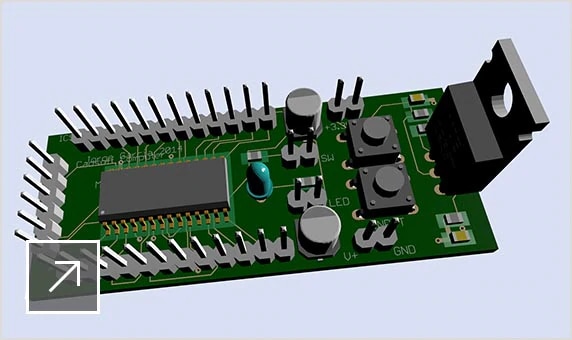When it comes to designing printed circuit boards (PCBs), understanding the nuances of various standards and requirements is crucial for ensuring reliability and performance. One such standard that often raises questions among engineers and manufacturers is the Class 3 annular ring requirement. This specification is particularly important for high-reliability applications, such as aerospace, medical devices, and telecommunications, where performance and durability are non-negotiable. In this blog post, we'll delve into the essentials of the Class 3 annular ring requirement, exploring its significance, guidelines, and best practices to help you navigate the complexities of PCB design with confidence.
Pcb Design Annular Ring
When it comes to PCB design, understanding the annular ring requirement is crucial, especially for Class 3 boards, which are often used in high-reliability applications such as aerospace and medical devices. The annular ring refers to the ring of conductive material that surrounds a plated through-hole, serving as a critical connection point for traces and vias. For Class 3 PCBs, the annular ring must meet specific thickness and width criteria to ensure durability and performance under extreme conditions. A well-designed annular ring helps prevent issues like pad cratering and ensures reliable electrical connections, ultimately contributing to the overall integrity and functionality of the PCB. In this blog post, we'll delve deeper into the specific requirements and best practices for designing annular rings that comply with Class 3 standards.
 summitinterconnect.com
summitinterconnect.com The Most Comprehensive Guide You Need Most About Pcb Annular Ring
When it comes to designing printed circuit boards (PCBs) for high-reliability applications, understanding the annular ring requirements is crucial, especially for Class 3 PCBs. This comprehensive guide will delve into the specifics of annular ring dimensions, which are essential for ensuring robust connections between pads and vias. We will explore the industry standards, the implications of insufficient annular rings, and best practices for achieving optimal designs that meet the stringent demands of Class 3 applications. Whether you're a seasoned engineer or new to PCB design, this guide will equip you with the knowledge you need to ensure your PCBs are not only functional but also reliable in critical environments.
 www.wellpcb.com
www.wellpcb.com Annular Ring In Pcb
In the realm of PCB manufacturing, understanding the concept of annular rings is crucial, especially when dealing with Class 3 PCBs, which are designed for high-reliability applications. An annular ring refers to the ring of conductive material that surrounds a plated through-hole, connecting the hole to the PCB's surface. For Class 3 PCBs, the annular ring must meet specific requirements to ensure optimal electrical performance and mechanical stability, particularly in environments subject to thermal cycling or vibration. A well-defined annular ring not only enhances the integrity of the connections but also plays a vital role in minimizing the risk of defects during the manufacturing process. Therefore, adhering to the guidelines for annular ring dimensions and tolerances is essential for engineers and manufacturers aiming to produce reliable and durable printed circuit boards.
 www.jarnistech.com
www.jarnistech.com Annular Rings In Pcb Board
Annular rings play a crucial role in the integrity and reliability of printed circuit boards (PCBs), particularly in Class 3 applications where high-performance and durability are essential. An annular ring is the area of copper that surrounds a plated hole, serving as a connection point for electrical components. For Class 3 PCBs, which are often used in critical applications like medical devices and aerospace systems, the annular ring requirements are stringent. These specifications ensure that the rings are adequately sized and positioned to prevent issues such as micro-cracking, which can lead to circuit failures. Understanding the importance of proper annular ring design not only enhances the functionality of the PCB but also contributes to the overall safety and longevity of the electronic devices they support.
 www.pcbaaa.com
www.pcbaaa.com Annular Rings
Annular rings play a crucial role in the integrity and performance of printed circuit boards (PCBs), particularly when it comes to Class 3 requirements. In essence, an annular ring is the conductive ring of copper that surrounds a plated-through hole, serving as a connection point for electrical pathways. For Class 3 PCBs, which are designed for high-reliability applications such as aerospace and medical devices, the annular ring must meet stringent specifications to ensure durability and performance under extreme conditions. This includes considerations for ring thickness, diameter, and the overall quality of the plating process. Understanding these requirements is essential for manufacturers to produce reliable PCBs that can withstand the rigors of their intended applications.
 www.multi-circuit-boards.eu
www.multi-circuit-boards.eu Other Wiring Gallery

www.pcblibraries.com
Minimum Annular Ring

summitinterconnect.com
Plated Thru Hole Annular Ring Class 2, Class3 And Tangency "class 3
pcb.iconnect007.com
Connect The Dots: What Is An Annular Ring?

summitinterconnect.com
Pcb Design Annular Ring
www.huiwenedn.com
Meeting Standards: Ipc 6012 Class 3 Annular Ring

jhdpcb.com
In-depth Guide To Pcb Annular Ring Manufacturing

pcbassemblymanufacturing.com
Pcb Annular Ring In Printed Circuit Board Design

resources.altium.com
You Might Also Like: Tiffin Allegro Bus Wiring Diagram
Meeting Standards: Ipc 6012 Class 3 Via Sizes And Annular Rings
